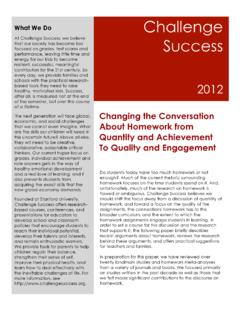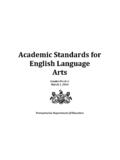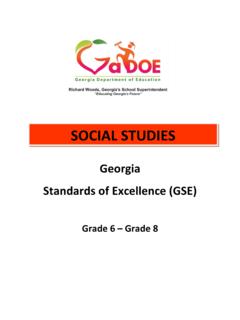Transcription of Communication: Speaking, Listening, Media Literacy
1 English Standards of Learning for Virginia Public Schools - January 2010. grade Ten The tenth- grade student will become a skilled communicator in small-group learning activities. The student will examine, analyze, and produce Media messages. The student will continue development of vocabulary, with attention to connotations, idioms, allusions, and evolution of language. The student will read and analyze literary texts from a variety of eras and cultures. Attention will be given to the analysis of nonfiction texts. The student will critique the writing of peers and professionals, using analysis to improve writing skills.
2 The student will continue to build research skills by crediting sources and presenting information in a format appropriate for content. Grammar knowledge will be expanded as the student presents, writes, and edits materials, applying the conventions of language. *The bodies of literature for grades 10, 11, and 12 are interchangeable and may be taught in any of these grades.*. Communication: Speaking, Listening, Media Literacy The student will participate in, collaborate in, and report on small-group learning activities. a) Assume responsibility for specific group tasks. b) Collaborate in the preparation or summary of the group activity.
3 C) Include all group members in oral presentation. d) Choose vocabulary, language, and tone appropriate to the topic, audience, and purpose. e) Demonstrate the ability to work effectively with diverse teams to accomplish a common goal. f) Collaborate with others to exchange ideas, develop new understandings, make decisions, and solve problems. g) Access, critically evaluate, and use information accurately to solve problems. h) Evaluate one's own role in preparation and delivery of oral reports. i) Use a variety of strategies to listen actively. j) Analyze and interpret other's presentations.
4 K) Evaluate effectiveness of group process in preparation and delivery of oral reports. The student will analyze, produce, and examine similarities and differences between visual and verbal Media messages. a) Use Media , visual Literacy , and technology skills to create products. b) Evaluate sources including advertisements, editorials, blogs, Web sites, and other Media for relationships between intent, factual content, and opinion. c) Determine the author's purpose and intended effect on the audience for Media messages. d) Identify the tools and techniques used to achieve the intended focus.
5 1. English Standards of Learning for Virginia Public Schools - January 2010. Reading The student will apply knowledge of word origins, derivations, and figurative language to extend vocabulary development in authentic texts. a) Use structural analysis of roots, affixes, synonyms, antonyms, and cognates to understand complex words. b) Use context, structure, and connotations to determine meanings of words and phrases. c) Discriminate between connotative and denotative meanings and interpret the connotation. d) Identify the meaning of common idioms. e) Identify literary and classical allusions and figurative language in text.
6 F) Extend general and specialized vocabulary through speaking, reading, and writing. g) Use knowledge of the evolution, diversity, and effects of language to comprehend and elaborate the meaning of texts. The student will read, comprehend, and analyze literary texts of different cultures and eras. a) Identify main and supporting ideas. b) Make predictions, draw inferences, and connect prior knowledge to support reading comprehension. c) Explain similarities and differences of techniques and literary forms represented in the literature of different cultures and eras. d) Analyze the cultural or social function of literature.
7 E) Identify universal themes prevalent in the literature of different cultures. f) Examine a literary selection from several critical perspectives. g) Explain the influence of historical context on the form, style, and point of view of a literary text. h) Evaluate how an author's specific word choices, syntax, tone, and voice shape the intended meaning of the text, achieve specific effects and support the author's purpose. i) Compare and contrast literature from different cultures and eras. j) Distinguish between a critique and a summary. k) Compare and contrast how rhyme, rhythm, sound, imagery, style, form, and other literary devices convey a message and elicit a reader's emotions.
8 L) Compare and contrast character development in a play to characterization in other literary forms. m) Use reading strategies to monitor comprehension throughout the reading process. 2. English Standards of Learning for Virginia Public Schools - January 2010. The student will read, interpret, analyze, and evaluate nonfiction texts. a) Identify text organization and structure. b) Recognize an author's intended audience and purpose for writing. c) Skim manuals or informational sources to locate information. d) Compare and contrast informational texts. e) Interpret and use data and information in maps, charts, graphs, timelines, tables, and diagrams.
9 F) Draw conclusions and make inferences on explicit and implied information using textual support as evidence. g) Analyze and synthesize information in order to solve problems, answer questions, and generate new knowledge. h) Use reading strategies throughout the reading process to monitor comprehension. Writing The student will develop a variety of writing to persuade, interpret, analyze, and evaluate with an emphasis on exposition and analysis. a) Generate, gather, plan, and organize ideas for writing to address a specific audience and purpose. b) Synthesize information to support the thesis.
10 C) Elaborate ideas clearly through word choice and vivid description. d) Write clear and varied sentences, clarifying ideas with precise and relevant evidence. e) Organize ideas into a logical sequence using transitions. f) Revise writing for clarity of content, accuracy, and depth of information. g) Use computer technology to plan, draft, revise, edit, and publish writing. The student will self- and peer-edit writing for correct grammar, capitalization, punctuation, spelling, sentence structure, and paragraphing. a) Distinguish between active and passive voice. b) Apply rules governing use of the colon.
















